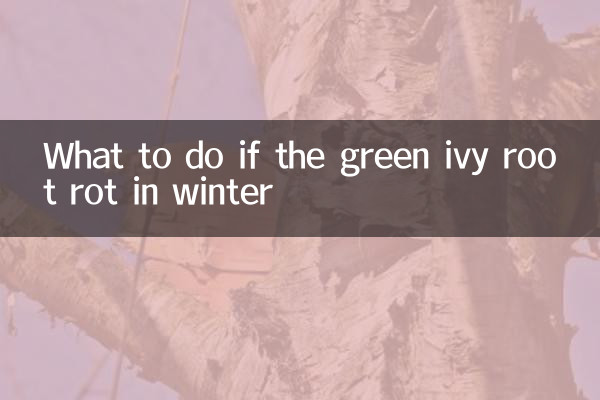What to do if the roots of green ivy rotten in winter
Winter is a high-incidence period when green ivy is prone to root rot. Low temperature, improper watering or poor ventilation may cause the root system of green ivy to rot. This article will combine popular topics and hot contents on the Internet for the past 10 days to analyze the causes and solutions for the root rot in winter and attach structured data for reference.
1. Common reasons for root rot in green ivy

Green ivy root rot is usually caused by the following reasons:
| reason | Specific performance |
|---|---|
| Too much watering | The soil is moist for a long time and the roots cannot breathe |
| Low temperature frostbite | In winter, the room temperature is lower than 10℃, and the root system is frozen |
| Poor ventilation | The air is not circulating, and the soil moisture is difficult to evaporate |
| Basin soil knot | Poor soil drainage and severe water accumulation |
2. How to determine whether the green ivy is rotten
The following are typical symptoms of root rot in green ivy:
| symptom | illustrate |
|---|---|
| Yellow leaves | From the bottom leaves start to turn yellow and gradually spread |
| Stubal soft | The stems become soft and even dark brown spots appear |
| Soil smell | The pot soil smells rotten |
| Root system turns black | The root system of the plant can be seen to be black and rotten |
3. First aid measures for root rot in green ivy
If you find a root rot in green ivy, you can follow the following steps to perform first aid:
| step | Operation Instructions |
|---|---|
| 1. Remove the plant | Gently remove the green ivy from the flower pot to avoid damage to the roots |
| 2. Clean up rotten roots | Use disinfection scissors to cut off the black and rotten root system |
| 3. Disinfection treatment | Soak the roots in pyrimidine solution for 10 minutes |
| 4. Replace the pot soil | Replant with new loose and breathable soil |
| 5. Control watering | Keep the soil slightly moist after planting |
4. Key points for maintenance of green ivy in winter
In order to prevent the root rot of green ivy in winter, the following points should be paid attention to in daily maintenance:
| Maintenance points | Specific measures |
|---|---|
| Temperature control | Keep room temperature above 15℃ to avoid low temperature frostbite |
| Water appropriately | Reduce watering frequency in winter and keep the soil slightly dry |
| Increase light | Appropriately increase scattered light to promote photosynthesis |
| Regular ventilation | Choose a warm time to open the windows for ventilation |
5. Other tips to prevent root rot in green ivy
1.Choose the right flower pot: It is recommended to use pottery pots or clay pots with good breathability, and avoid using too large flower pots.
2.Improved soil structure: Perlite or vermiculite can be added to the soil to improve drainage.
3.Winter fertilization control: Green ivy grows slowly in winter, and fertilization should be stopped or the frequency of fertilization should be reduced.
4.Regular root check: The root system can be checked every 2-3 months to find problems in a timely manner.
5.Hydroponic transformation into soil: If root rot problems occur many times, you can consider converting green ivy to hydroponic for maintenance.
6. Management of the recovery period after the root rot of green ivy
Green ivy needs a recovery period of 1-2 months after the root rot treatment, so special attention should be paid to this period:
| time | Management points |
|---|---|
| Week 1 | Keep the environment warm and avoid direct light |
| 2-4 weeks | Observe the growth of new leaves and control the amount of watering |
| 1-2 months | Gradually restore normal maintenance and apply a small amount of fertilizer |
Through the above methods, most of the root-rooted green ivy can be effectively treated. Remember, the key to maintaining green ivy in winter is to control watering and maintain appropriate temperatures. With proper attention and care, your green ivy will surely survive the cold winter safely.

check the details

check the details